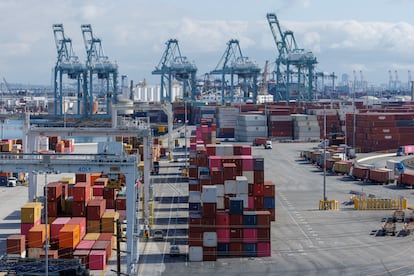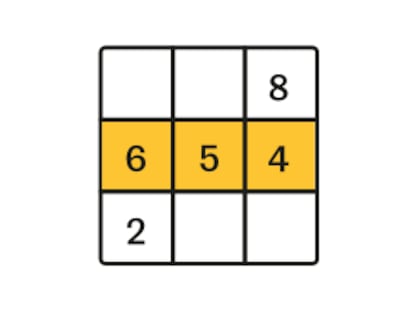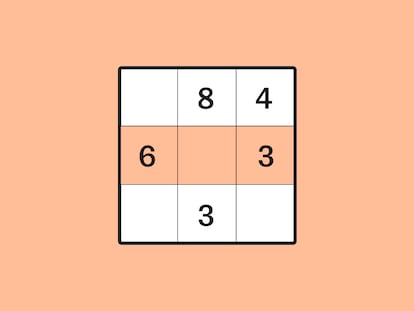Five charts that explain the US-China trade relationship
In 2024, Washington’s deficit with Beijing reached nearly $300 billion, highlighting a persistent imbalance and America’s reliance on key products from the Asian giant

U.S. President Donald Trump has granted the world a temporary reprieve by halting the implementation of the so-called “reciprocal tariffs” for 90 days. All countries have benefited from this measure, except China, with which he has escalated the trade war by imposing a total tariff of 145%.
This move effectively shuts off access to the U.S. market for one of its largest suppliers of goods, with which in 2024 it recorded the largest trade deficit — the difference between what a country exports to its trading partners and what it imports — according to data from the U.S. Census Bureau. The trade imbalance reached nearly $300 billion last year, marking a nearly 6% increase from 2023 and consolidating Beijing as the primary contributor to the U.S. trade deficit. This is the thorn in the side of the U.S. economy, which the Republican president frequently criticizes and views as a sign of weakness.
Below are five charts that illustrate the complex trade relationship between the two powers, currently embroiled in a dispute whose repercussions could be felt on a global scale.
Unbalanced trade
U.S. exports to China reached $143.5 billion in 2024, down 3% from 2023. Imports, meanwhile, increased by almost the same amount, reaching $438.9 billion. This has resulted in a widening trade deficit between Washington and Beijing, which exceeded $295.4 billion last year.
The increase highlights the persistent disparities in bilateral trade, which have continued to worsen since the start of the 21st century. Despite the political turmoil sparked by Trump, the trade relationship between the two countries remained relatively stable in the first months of the year. According to official data, the flow of goods continues to favor Beijing, with Washington’s trade balance with China showing a deficit of $52.911 billion through February. Chinese imports accounted for 12% of all U.S. imports, second only to Mexico, which represented 13.8%.
Persistent deficit
The trade balance reveals that since 2000, Washington has purchased far more goods from the Asian giant than it has sold. This resulted in the trade deficit reaching a historic high of $418.2 billion in 2018, a figure that has since moderately declined due to changes in trade policies and disruptions caused by the pandemic. Notably, the largest imbalance occurred during President Trump’s first term, a period during which he imposed severe trade restrictions on Chinese products. These measures contributed to a slowdown in China’s economy and led to a nearly 50% drop in U.S. exports to China by the end of 2018. In contrast, the strength of the dollar that year boosted the purchasing power of American consumers, driving domestic consumption.
What does the US buy from China?
The United States relies heavily on Chinese manufacturing to meet its domestic demand for consumer goods and technology. Among the main products imported from China are telephones, computers, semiconductors, furniture, toys, and textiles. Electronics and machinery alone accounted for more than 50% of the total value of imports, according to foreign trade data.
In contrast, U.S. exports to China are more diversified, but considerably lower in volume. They are primarily composed of products such as aircraft, vehicles, semiconductors, industrial machinery, and agricultural goods like soybeans and beef. While these sectors are strategically important to the U.S. economy, they are limited in scale compared to the vast volume of imports from the Chinese market.
Largest trade deficit
Nearly half of the U.S. trade imbalance between imports and exports is concentrated in three nations that have been primary targets of Trump’s trade policies: China, Mexico, and Canada, in that order. Mexico has emerged as the top export partner to the United States, overtaking China in 2023 and solidifying its position in 2024. Thanks to the preferential access granted by the United States-Mexico-Canada Agreement (USMCA), Mexico has capitalized on its geographic proximity and trade ties with the U.S. market.
China, for its part, has relinquished its position as the leading supplier of goods to the United States but remains the country with which Washington has the largest trade deficit. The latest data from the U.S. Census Bureau shows that as of February, the largest negative trade balance in goods was recorded with China, followed by Switzerland and Mexico. These figures explain why Trump has chosen Beijing as his primary target in this new trade war. On Thursday, the White House issued a decree formalizing the increase in the “reciprocal tariff” on China, clarifying that the tax has risen to 125%. This measure is in addition to another tariff previously imposed by Washington on Beijing because of China’s alleged export of fentanyl precursors, set at 20%. As a result, the current total tariffs on China now stand at 145%.
Sign up for our weekly newsletter to get more English-language news coverage from EL PAÍS USA Edition
Tu suscripción se está usando en otro dispositivo
¿Quieres añadir otro usuario a tu suscripción?
Si continúas leyendo en este dispositivo, no se podrá leer en el otro.
FlechaTu suscripción se está usando en otro dispositivo y solo puedes acceder a EL PAÍS desde un dispositivo a la vez.
Si quieres compartir tu cuenta, cambia tu suscripción a la modalidad Premium, así podrás añadir otro usuario. Cada uno accederá con su propia cuenta de email, lo que os permitirá personalizar vuestra experiencia en EL PAÍS.
¿Tienes una suscripción de empresa? Accede aquí para contratar más cuentas.
En el caso de no saber quién está usando tu cuenta, te recomendamos cambiar tu contraseña aquí.
Si decides continuar compartiendo tu cuenta, este mensaje se mostrará en tu dispositivo y en el de la otra persona que está usando tu cuenta de forma indefinida, afectando a tu experiencia de lectura. Puedes consultar aquí los términos y condiciones de la suscripción digital.
More information
Archived In
Últimas noticias
Most viewed
- Reinhard Genzel, Nobel laureate in physics: ‘One-minute videos will never give you the truth’
- Oona Chaplin: ‘I told James Cameron that I was living in a treehouse and starting a permaculture project with a friend’
- Pablo Escobar’s hippos: A serious environmental problem, 40 years on
- Charles Dubouloz, mountaineering star, retires at 36 with a farewell tour inspired by Walter Bonatti
- Why we lost the habit of sleeping in two segments and how that changed our sense of time










































